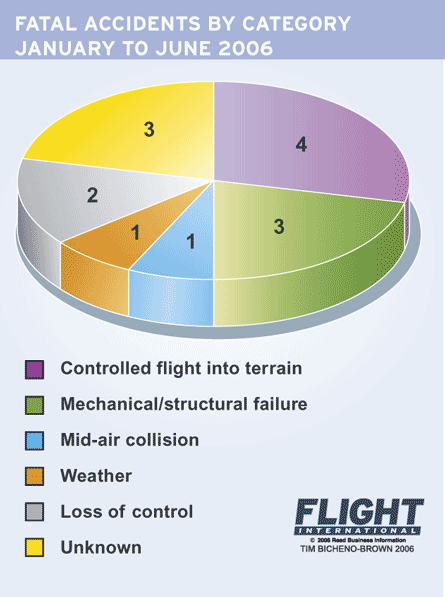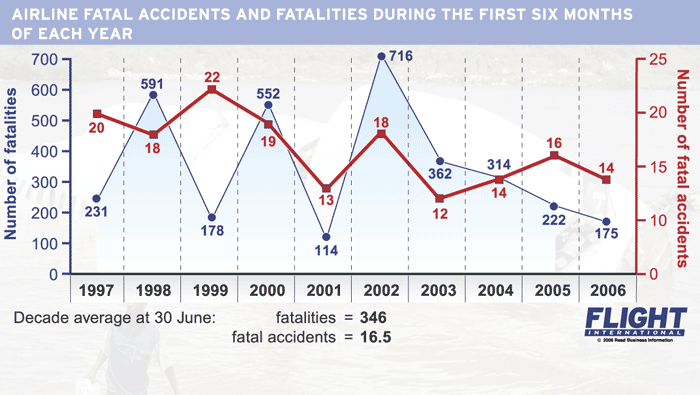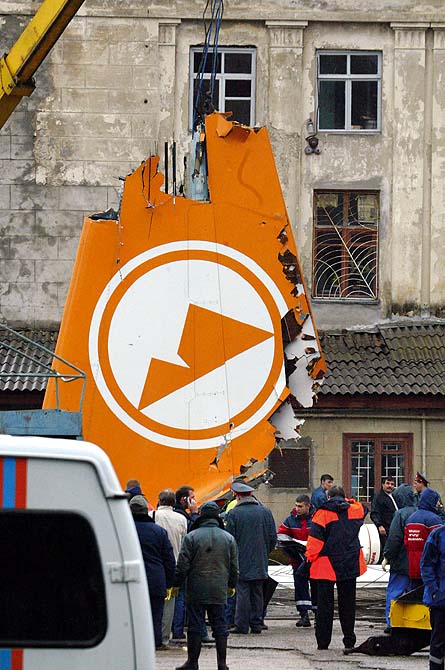Airline accident figures for the first six months of this year continue an improving safety trend compared with the same periods in the past 10 years, but it looks as if this downward slope in fatal accident numbers might be bottoming out. At a time when the commercial air transport industry is firmly re-established in a period of traffic growth following the dip after the 11 September terrorist attacks, the number of fatal airline accidents remains low compared with the half-year average for the decade.
|
|---|
| The fin of the Armavia Airbus A320, which crashed off Russia's Black Sea coast in the worst accident so far this year |
This year, up to 30 June, there have been 14 fatal airline accidents compared with 16 the previous year, and the relative comparison for the number of fatalities was 176 against 222. The majority of crashes involved small aircraft, with the largest number of fatal accidents in any single operator category - seven of the 14 - occurring among non-passenger operations (cargo, positioning or line training). The first six months were free of big jet accidents involving major world carriers, but 2005 provided a reminder that the first half is no indicator of what the second six months may bring. Last year there was a rash of serious accidents during August and September.
Worst accident
By far the worst accident so far this year - in terms of fatalities - involved a latest-generation aircraft, which is a relatively rare event. This was the Armavia Airbus A320 crash in the Black Sea offshore from Sochi in Russia. Just as in the case of the August 2000 Gulf Air A320 crash offshore from Bahrain, this accident proves that pilots can lose control of even a flight-envelope-protected aircraft if they lose situational awareness, particularly while flying manually.
Early reports from the CIS Interstate Aviation Committee (MAK) investigators say the aircraft's flight data recorder indicates there were no evident problems with the aircraft or engines. The manoeuvre during which things began to go wrong, however, was the same in the Sochi and the Bahrain accidents: in both cases the crew had abandoned their approach and were carrying out climbing turns at night over water; but the climbing turns became descending turns to the point of impact. In the 2000 accident, the Bahraini investigators also found no fault with the aircraft, engines or systems, but the pilots did not notice how the aircraft's attitude and trajectory was developing until it was too late to save the aeroplane.
Meanwhile, the report on the 2004 Flash Airlines Boeing 737-300 accident, published in March, confirms that the captain, also carrying out a climbing turn at night over the sea, lost control because of disorientation.
There is a strong message for airline training departments here. Director of technical programmes at the Flight Safety Foundation Jim Burin says there is a debate about how to categorise accidents in which the aircraft has nothing technically wrong with it and is flying within its flight envelope when it hits the ground. Some argue this could be classified as controlled flight into terrain (CFIT), whereas others contend that - since the pilot is an essential part of the total system - if he has completely lost his sense of the aircraft's attitude or trajectory, valid decisions about the aircraft's attitude cannot be made: therefore a trajectory he commands that results in impact with the ground because of his disorientation is a loss of control (LOC) accident.
Pilot disoriented
Burin points out that in the Gulf Air accident the aircraft was under control at all times according to the report, but the pilot was disorientated at least partially by "somonographic illusion". The latter is the sensation - caused by the acceleration associated with the go-around the Gulf Air aircraft was carrying out - that the aircraft was pitching up more than commanded, to which the captain reacted with a nose-down sidestick input that led to the crash into the sea. Burin comments that it will be "interesting to see if the same dynamics were present with Armavia" - that is, acceleration combined with a loss of outside visual references.
 |
|---|
Burin's verdict on safety in the year to 30 June is that it was "impressive for commercial jets", with just three hull losses, with only one involving fatalities. Putting it into context, he says: "Because of everyone's impressive efforts there is less than one accident per million departures - actually around 0.76 per million - so an accident is almost a random event. Thus having only three [hull-loss] accidents so far is not much more unusual than having four in one month, as happened in August 2005."
 |
|---|
Burin adds: "As the industry knows, 2004 was the first year in history in which we had no commercial jet CFIT accidents. In 2005 there were seven, involving five Western-built and two Eastern-built aircraft. Plus there was one corporate jet CFIT and nine commercial turboprop CFIT accidents." This year to 30 June there had been four or five CFIT accidents - depending on whether the Armavia accident is resolved under that category or as a LOC crash. Among the others, one involved a jet (Antonov An-74) and the remaining three were turboprops.
The killers
"I don't have enough information to determine if Armavia was LOC or CFIT, but combined they are the big killers - over 75% of all fatalities," Burin says. So if 2005 proved the big killers had not been defeated, this year is on the way to confirming it.
Meanwhile, the second half of 2006 is not starting well: an S7 Airlines - formerly Sibir - Airbus A310-300 has overrun the runway at Irkutsk with only about 70 of its 190 or so passengers surviving the subsequent fire; the Democratic Republic of the Congo has continued to enhance its reputation as the world's prime graveyard of old Antonov freighters with a Mango Airlines An-12 crashing after an en-route engine failure, causing the loss of all six crew lives, and a Pakistan International Airlines Fokker F27 has crashed, killing all 45 people on board. ■
Source: Flight International
























